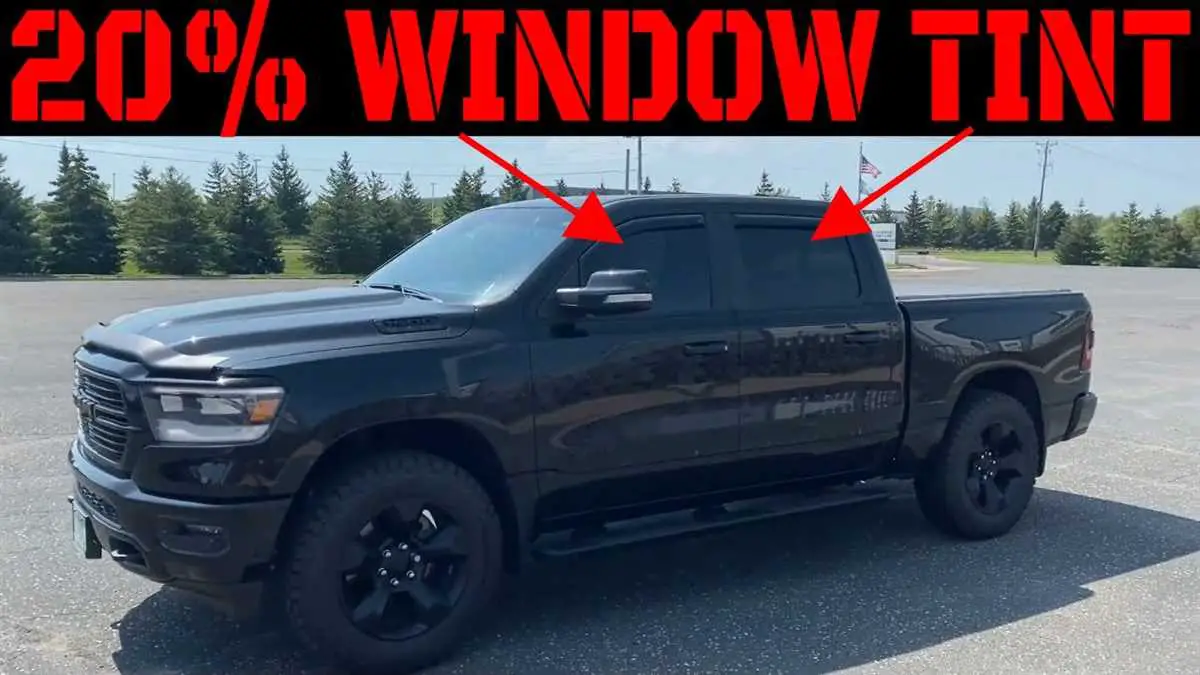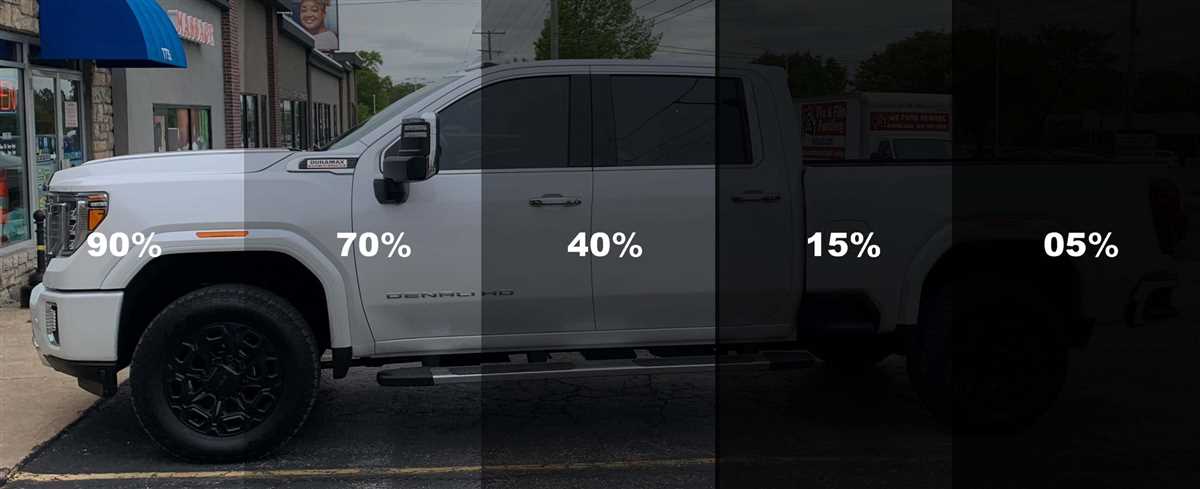Last Updated on February 27, 2024 by Vadym

Window tinting is not only a popular way to enhance the appearance of your truck, but it also offers several practical benefits. Tinted windows provide privacy, reduce glare, and block harmful UV rays. If you are looking to give your truck a sleek and stylish look while enjoying these advantages, then tinting your truck windows is a great option.
Before you start the process, it’s important to understand the laws and regulations regarding window tinting in your area. Different states and countries have different rules regarding the darkness and reflectiveness of window tint. Make sure to research and comply with these regulations to avoid any legal issues.
Once you have checked the legal requirements, you can proceed to the actual tinting process. The first step is to gather all the necessary materials, including window tint film, a heat gun or hairdryer, a razor blade or utility knife, a squeegee, and a clean cloth. You can find window tint film at automotive supply stores or online.
Start by thoroughly cleaning the truck windows using a glass cleaner and a clean cloth. Make sure to remove any dirt, dust, or fingerprints from the surface. This will ensure that the tint adheres properly and provides a smooth finish. Once the windows are clean, measure and cut the tint film according to the size of each window. Be sure to leave a small margin around the edges to allow for any adjustments during the installation process.
Choosing the Right Window Tint Film
When it comes to tinting your truck windows, choosing the right window tint film is crucial. The type of film you select will determine the level of privacy, protection, and style you achieve. Here are a few factors to consider when choosing the right window tint film for your truck:
1. Legal Restrictions:
Before deciding on a window tint film, familiarize yourself with the laws and regulations in your area. Different regions may have specific rules regarding the allowed Visible Light Transmission (VLT) levels for vehicle window tints. Ensure you select a film that complies with local regulations to avoid any potential legal issues.
2. VLT Percentage:
The VLT percentage refers to the amount of visible light that can pass through the tinted windows. The lower the percentage, the darker the tint. If you prefer more privacy, you may opt for a film with a lower VLT percentage. However, keep in mind that extremely dark tints may affect visibility, especially during nighttime driving.
3. UV Protection:
One important benefit of window tint films is their ability to block harmful UV rays from the sun. UV protection is essential for safeguarding the interior of your truck, as constant exposure to sunlight can cause fading and deterioration. Look for a film that provides a high level of UV protection to preserve the condition of your seats, dashboard, and other interior components.
4. Heat Rejection:
Another key consideration is the film’s heat rejection properties. A quality window tint film should help keep the interior of your truck cool by reducing the amount of heat that enters the cabin. This can enhance your comfort, particularly during hot summer months. Look for a film with a high heat rejection rating to effectively combat the sun’s heat.
5. Quality and Durability:
Investing in a high-quality window tint film is essential for long-lasting results. Look for a film that is scratch-resistant and durable to ensure it withstands everyday wear and tear. Additionally, pay attention to warranty options offered by the manufacturer, as this can be an indicator of the film’s quality and longevity.
By considering these factors and choosing the right window tint film for your truck, you can enjoy the benefits of enhanced privacy, UV protection, heat rejection, and a stylish appearance while driving.
Understanding Different Types of Window Tint
When it comes to tinting your truck windows, it’s important to understand the different types of window tint available. The type of tint you choose will depend on your specific needs and preferences. Here are some common types of window tint:
1. Dyed Window Tint:
Dyed window tint is a common and affordable option. It is made by applying a layer of dye to the film, which creates a darker appearance. This type of tint helps to reduce glare and protect your truck’s interior from harmful UV rays. However, it doesn’t provide as much heat rejection as other types of tint.
2. Metalized Window Tint:
Metalized window tint is another popular choice. It is made by layering metal particles onto the film, which gives it a reflective appearance. This type of tint offers excellent heat rejection and can significantly reduce the amount of heat that enters your truck’s cabin. It also provides good UV protection and helps to reduce glare.
3. Carbon Window Tint:
Carbon window tint is a premium option that offers a stylish and luxurious look. It is made by layering carbon particles onto the film, which creates a dark, matte finish. This type of tint provides excellent heat rejection, UV protection, and glare reduction. It also helps to reduce fading of your truck’s interior materials.
4. Ceramic Window Tint:
Ceramic window tint is the highest quality and most expensive option. It is made by layering ceramic particles onto the film, which provides excellent heat rejection and superior clarity. This type of tint offers the highest level of UV protection, reduces glare, and helps to keep your truck’s interior cool. It is also less likely to interfere with electronic devices.
When choosing the right type of window tint for your truck, consider factors such as your budget, desired appearance, and the level of heat rejection and UV protection you need. Consult with a professional tinting service to ensure you choose the best option for your specific requirements.
Gathering the Necessary Tools and Materials
Before you begin tinting your truck windows, it’s important to gather all the necessary tools and materials. Having everything on hand will make the process go smoothly and efficiently. Here are the items you will need:
- Tint film: Choose a high-quality tint film that is specifically designed for automotive use.
- Spray bottle: Fill a spray bottle with a solution of soapy water. This will be used to wet the windows during the tinting process.
- Squeegee: An automotive-grade squeegee will help you remove air bubbles and excess water from under the tint film.
- Heat gun: A heat gun is needed to shrink the tint film and mold it to the shape of the windows.
- Utility knife: A sharp utility knife will be used to cut the tint film to the correct size and shape for each window.
- Lint-free cloth: Use a lint-free cloth to clean the windows before applying the tint film.
- Tape measure: A tape measure will help you accurately measure the size of each window.
- Plastic scraper: A plastic scraper is useful for removing any old tint film or adhesive residue from the windows.
- Protective gloves: Wear protective gloves to protect your hands from the tint film and any chemicals used during the process.
Having all these tools and materials ready will ensure a successful truck window tinting project. Once you have everything prepared, you can move on to the next steps of the process.
Preparing the Truck Windows for Tinting
Before you start tinting your truck windows, it’s important to properly prepare the windows to ensure a smooth and successful installation. Follow these steps to prepare your truck windows for tinting:
- Thoroughly clean the windows: Begin by cleaning the windows inside and out using a glass cleaner. Make sure to remove any dirt, dust, and grime from the surface of the windows to ensure that the tint adheres properly.
- Remove any stickers or decals: If there are any stickers or decals on the windows, carefully remove them using a plastic scraper or your fingernail. Wipe away any adhesive residue with a clean cloth and glass cleaner.
- Inspect for damage: Carefully inspect the windows for any chips, cracks, or damage. If you notice any damage, it’s important to repair or replace the window before proceeding with the tinting process.
- Tape off the edges: To protect the paint and rubber seals around the windows, apply painter’s tape along the edges. This will help prevent any accidental damage or overspray during the tinting process.
- Remove any window accessories: If your truck has any window accessories such as weatherstripping or trim pieces, remove them before starting the tinting process. This will make it easier to apply the tint and ensure a clean installation.
- Dry the windows: After cleaning and inspecting the windows, use a clean cloth or paper towel to dry them completely. This will help the tint adhere properly and avoid any air bubbles or imperfections.
By properly preparing your truck windows before tinting, you can ensure a professional-looking result and increase the longevity of the tint. Take your time with each step and make sure to follow the manufacturer’s instructions for the specific tint product you are using.
Applying the Window Tint Film
Applying the window tint film to your truck windows requires careful preparation and attention to detail. Follow these steps to ensure a professional-looking tint job:
1. Clean the windows: Thoroughly clean the inside of the windows with glass cleaner and a lint-free cloth. Remove any dust, dirt, or fingerprints to ensure the tint film adheres properly.
2. Measure and cut the film: Measure each window individually and cut the tint film about 1 inch larger than the dimensions of the window. This will allow you to trim the excess film later for a perfect fit.
3. Wet the window: Spray a liberal amount of soapy water onto the inside of the window. This will create a slippery surface that allows you to position the tint film without it sticking prematurely.
4. Position the film: Peel the protective backing off the tint film and carefully position it onto the wet window. Start with the top edge and work your way down, smoothing out any air bubbles or wrinkles as you go.
5. Trim the excess film: Use a sharp utility knife to trim the excess film from the edges of the window. Be careful not to scratch the glass. Use a squeegee or similar tool to press the film against the window, removing any remaining air bubbles or water.
6. Allow the film to dry: Allow the tint film to dry completely, following the manufacturer’s recommendations. This usually takes about 24 hours, but can vary depending on the climate and humidity levels.
7. Clean and maintain the film: Once the film is dry, you can clean it with a mild window cleaner and a soft cloth. Avoid using abrasive cleaners or scrubbing the film too vigorously, as this can cause damage.
By following these steps, you can apply tint film to your truck windows and achieve a sleek, professional finish. Remember to check your local laws and regulations regarding the darkness and placement of window tint before starting the project.
Proper Techniques for a Smooth Application
When tinting your truck windows, it’s important to follow proper techniques to ensure a smooth and successful application. Here are some tips to help you achieve the desired results:
1. Clean and Prepare the Windows:
Before starting the tinting process, make sure to thoroughly clean the truck windows with a mild glass cleaner and a lint-free cloth. Remove any dirt, dust, or fingerprints to ensure a smooth surface for the tint film to adhere to.
2. Measure and Cut the Tint Film:
Measure the dimensions of your truck windows accurately and use a sharp blade or tint cutting tool to cut the tint film to the correct size. It’s important to cut the film slightly larger than the window to allow for precise placement and trimming during the application process.
3. Wet the Window:
Thoroughly wet the truck window with a spray bottle filled with a mixture of water and a few drops of dish soap. This will help lubricate the window and allow for easier positioning and adjustment of the tint film.
4. Apply the Tint Film:
Carefully peel off the backing film from the tint and spray the adhesive side of the film with the water and soap mixture. Position the film onto the wet window and adjust it as needed to fit the window perfectly. Use a squeegee to smooth out any air bubbles or wrinkles, starting from the center and working your way out to the edges.
5. Trim Excess Film:
After applying the tint film, use a sharp blade to trim any excess film around the edges of the window. Be careful not to scratch the glass while trimming. This step will give your truck windows a clean and professional finish.
6. Let It Dry:
Allow the tint film to dry completely before rolling down the windows or touching it. This usually takes about 24-48 hours, depending on the climate and temperature. Avoid any contact or tampering with the film during the drying process to ensure its longevity and effectiveness.
Note: It’s essential to check and comply with local regulations and laws regarding window tinting. Ensure that the tint film you choose meets the legal requirements for your area.
Caring for Tinted Truck Windows

Once you have tinted your truck windows, it is important to properly care for them to maintain their appearance and longevity. Here are some tips on how to care for tinted truck windows:
- Wait before rolling down the windows: After tinting your truck windows, it is recommended to wait at least 48 hours before rolling down the windows. This allows the tint to fully adhere to the glass and prevents any damage.
- Use gentle cleaning products: When cleaning tinted windows, avoid using harsh chemicals or abrasive cleaning tools. Instead, use a mild soap or window cleaner and a soft microfiber cloth to gently clean the surface.
- Avoid scratching the tint: Be cautious when placing objects on the window sill or using window shades. Rough edges or hard materials can scratch the tinted film. Use caution when loading items into your truck to prevent any accidental damage.
- Avoid touching the inside of the windows: Fingerprints and oils from your hands can leave marks on the tinted windows. Try to avoid touching the inside of the windows as much as possible. If you do touch them, clean the area immediately with a soft cloth.
- Maintain the tinted film: Over time, the tinted film may start to bubble or peel. If you notice any issues with the tint, it is best to have it repaired or replaced by a professional to maintain the appearance and functionality of your truck windows.
By following these tips, you can ensure that your tinted truck windows stay in top condition for years to come. Regular maintenance and care will help preserve the appearance and functionality of the tinted film, keeping your truck looking stylish and providing privacy and protection.
Maintaining the Tinted Film’s Quality
After tinting your truck windows, it is crucial to take care of the tinted film to ensure its longevity and quality. Here are a few tips to help you maintain the tinted film’s appearance and performance:
1. Avoid touching the tinted surface: As much as possible, avoid touching the tinted surface with your bare hands or sharp objects. Constant contact can cause scratches or damage the film’s application. Use a clean, soft cloth or a microfiber towel when cleaning the windows.
2. Clean the windows with a mild solution: To clean the tinted windows, use a mild soap solution or a window cleaner that does not contain ammonia. Ammonia-based cleaners can cause the tinted film to crack or fade over time. Gently wipe the surface with the solution using a soft cloth or sponge, then dry it with a lint-free towel.
3. Avoid using abrasive materials: Do not use abrasive cleaning tools or materials, such as scrub brushes or harsh chemicals, on the tinted windows. These can damage the film and affect its quality. Stick to using non-abrasive cleaning methods to ensure the tint remains intact.
4. Be cautious when rolling down the windows: When tinting the windows, it is essential to wait for the film to fully set before rolling down the windows. This usually takes a few days. Also, be cautious when rolling them down to avoid peeling or scratching the tinted film.
5. Protect the tint from extreme heat: Excessive heat can cause the tinted film to bubble or warp. To prevent this, park your truck in shaded or covered areas whenever possible. If you live in a hot climate, consider using window visors or shades to further reduce the heat exposure.
6. Regularly inspect and touch up if needed: Periodically inspect the tinted film for any signs of damage or peeling. If you notice any issues, such as bubbles, cracks, or loose edges, it is advisable to seek professional help for touch-up or repair. Promptly addressing any problems will help maintain the longevity of the tinted film.
By following these maintenance tips, you can ensure that your truck’s tinted windows stay in excellent condition for years to come. Remember, proper care and attention are key to keeping the tinted film’s quality intact.
